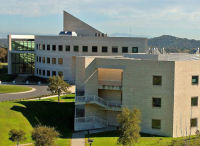 Virtually every business in California will be affected when the state's climate change bill, AB 32, kicks in next year. But one of the bill's co-authors says it's not likely to be as painful as many people fear.
Virtually every business in California will be affected when the state's climate change bill, AB 32, kicks in next year. But one of the bill's co-authors says it's not likely to be as painful as many people fear.
Compliance with the new rules for reducing greenhouse gas emissions will come in three forms: incentives, regulations, and some form of trading of emission costs and credits. Joe Nation explains that such a mechanism will reward those businesses that have already taken steps to reduce their carbon footprint.
{mp3remote}http://media.krcb.org/audio/nbr/base.mp3{/mp3remote}
Joe Nation
 California Gov. Arnold Schwarzenegger was joined by international leaders with a consistent record of addressing the global threat of climate change, New York Governor George Pataki and other environmental and industry leaders at the bill signing for AB 32 on Treasure Island in San Francisco on Tuesday, September 27, 2006.
California Gov. Arnold Schwarzenegger was joined by international leaders with a consistent record of addressing the global threat of climate change, New York Governor George Pataki and other environmental and industry leaders at the bill signing for AB 32 on Treasure Island in San Francisco on Tuesday, September 27, 2006.
Now, as the state's businesses prepare to work under the law's provisions, Joe Nation offers the following 11-point to do list to help them cope:
AB 32 "To DO" List
| Action Item | Specific Steps to Take |
| 1. Don't panic. | Think long term. AB 32 implementation will result in some modest economics challenges, but over several years, it will help more than it hurts. |
| 2. Know your energy and carbon footprint. | Knowing what you use and emit will help you create a reduction plan. Even if you don't have to reduce, you may have to report emissions. |
| 3. Make energy management and carbon management a priority. | Create your own company's version of the "Prius" effect. Energy users typically reduce consumption 10 percent just by monitoring their use. |
| 4. Become even more energy efficient. | Energy efficiency is usually the most cost-effective way to reduce energy costs. Do this before sinking scarce dollars in shiny new toys and technology. |
| 5. Reduce the carbon content of the energy you use. | After energy efficiency, then invest in renewables. |
| 6. Invest in new carbon reduction technologies and projects, including sequestration projects. | Businesses across California are hungry for carbon credit and other reduction projects, including forestry, dairy, and other efforts. If you build it in the North Bay, the rest of California will come. |
| 7. Think beyond electricity and natural gas reductions. | A majority of North Bay GHG emissions come from transportation. Focus on reducing your transportation footprint by implementing programs that offer pre-tax benefits to employees who take transit or carpool. Consider subsidized transit fares and guaranteed rides home. |
| 8. Think about your supply chain. | Work with your suppliers to help reduce their GHG emissions. It will lower their costs and ultimately yours. |
| 9. Take advantage of government, other assistance. | Use free utility audits and take advantage of forthcoming financing programs like AB 811, which make renewable energy projects more affordable. |
| 10. Start items 1-9 yesterday and have a timeline or goal for completion. | Set realistic internal targets and ensure that you meet them. |
| 11. Market your green accomplishments. | Consumers and your employees want to know you are reducing your GHG footprint. After you do, tell them and the rest of the world. |
From the Basque region of Spain comes a flourishing new business model that emphasizes cooperation as a key to innovation.
{mp3remote}http://media.krcb.org/audio/nbr/11-19-08.mp3{/mp3remote}

 Georgia Kelly(left) is the founder of the Sonoma-based Praxis Peace Institute. The Praxis website has details about the seminar they hosted at Mondragon in September, as well as a schedule of upcoming events, including their annual lunch, Dec. 6 with featured guests Swami Beyondanada and actress/activist Mimi Kennedy.
Georgia Kelly(left) is the founder of the Sonoma-based Praxis Peace Institute. The Praxis website has details about the seminar they hosted at Mondragon in September, as well as a schedule of upcoming events, including their annual lunch, Dec. 6 with featured guests Swami Beyondanada and actress/activist Mimi Kennedy.
Cooperative governance also leads to unorthodox responses to typical business problems. In the audio clip below, Kelly describes how the leadership and workforce at one of the Mondragon companies dealt with a unanticipated slowdown.
{mp3remote}http://media.krcb.org/audio/nbr/problem.mp3{/mp3remote}

The workforce at the Mondragon Cooperative's technology center.
From forgotten varieties of plums and apples to grapefuit and even bananas, an impressive array of rare fruits are growing in Sonoma County.
{mp3remote}http://media.krcb.org/audio/nbr/11-18-08.mp3{/mp3remote}
The California Rare Fruit Growers organization is internationally known for its devotion to cultivating and perpetuating fruit varieites that may otherwise go unnoticed and even face extinction. Even Sonoma County's favorite homegrown apple, the Gravenstein, is considered a rare or heritage variety in most other places.
{mp3remote}http://media.krcb.org/audio/nbr/grav.mp3{/mp3remote}
 The Redwood Empire Chapter of the California Rare Fruit Growers has events for local members as well as an annual community event to showcase the organization and demonstrate their grafting and planting techniques. Visitors can even select some cuttings to take home.
The Redwood Empire Chapter of the California Rare Fruit Growers has events for local members as well as an annual community event to showcase the organization and demonstrate their grafting and planting techniques. Visitors can even select some cuttings to take home.
Phil Pieri, president of the Redwood Empire chapter, retired to Sonoma County to fulfill his lifelong dream of growing food for his own table.
{mp3remote}http://media.krcb.org/audio/nbr/dream.mp3{/mp3remote}
 The USDA is preparing to adopt standards defnining exactly what can be labeled organically farmed fish. Not surprisingly, that's prompted a big debate behind the scenes.
The USDA is preparing to adopt standards defnining exactly what can be labeled organically farmed fish. Not surprisingly, that's prompted a big debate behind the scenes.
{mp3remote}http://media.krcb.org/audio/nbr/11-17-08.mp3{/mp3remote}


A typical "open pen" at a commercial salmon farm. These pens are usually arranged in larger groupings (such as the one shown in the photo below), linked by walkways that are used by the staff.

This commercial salmon fishing operation is in a deepwater cove off Lucas Bay, Alaska. Most of the world's salmon farming is done in the cold northern Pacific and Atlantic waters off North America.
 Urvashi Rangun (right) is a senior scientist and policy analyst for Consumer's Union, which is advocating for rigorous new standards for farmed seafood to be labled "organic."
Urvashi Rangun (right) is a senior scientist and policy analyst for Consumer's Union, which is advocating for rigorous new standards for farmed seafood to be labled "organic."
{mp3remote}http://media.krcb.org/audio/nbr/organic.mp3{/mp3remote}
Mixed news on the health care front: stem cell research is spurring advances in what's being called regenerative medicine, but California's budget crisis threatens the ability of community clinics to provide many basic services.
{mp3remote}http://media.krcb.org/audio/nbr/11-13-08.mp3{/mp3remote}

Dr. David Greenberg, Vice President of Special Research Projects for the Buck Institute for Age Research in Novato.
In addition to embryonic stem cells, Dr. Greenberg says current research is also studying adult stem cells.

{mp3remote}http://media.krcb.org/audio/nbr/adult.mp3{/mp3remote}
 Beatrice Bostick, Executive Director of Clinic Ole in Napa County warns that reducing health care coverage through Medi-Cal will inevitably result in greater demands for hospital emergency rooms, with no funds available for that care.
Beatrice Bostick, Executive Director of Clinic Ole in Napa County warns that reducing health care coverage through Medi-Cal will inevitably result in greater demands for hospital emergency rooms, with no funds available for that care.
{mp3remote}http://media.krcb.org/audio/nbr/er.mp3{/mp3remote}
stem cells

 Live Radio
Live Radio
